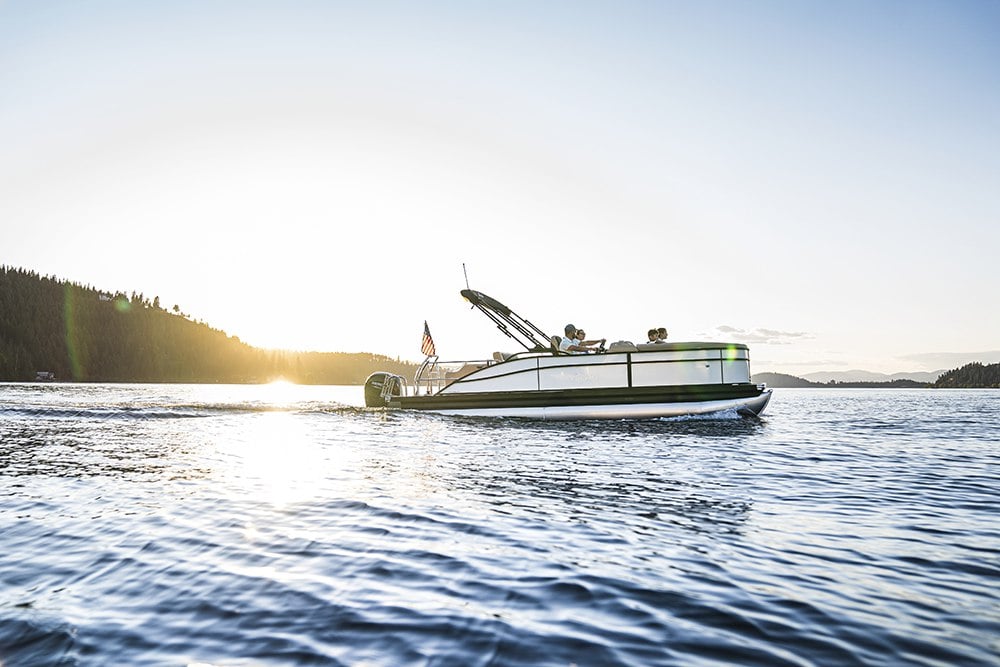Why Won’t my Pontoon Boat Start? (5 Troubleshooting Tips)
It’s late morning, the sun is beating on the deck and the humidity is kicking in. The heat quickly shoots up to 85 degrees and it’s not going to stop there. Today is the perfect boat day for you and the family.
Preparing to board the pontoon boat can be a process. You pack the boat bag, prepare snacks and sandwiches, ice down the cooler, and gather any other pontoon boat accessory worth taking up space on your vessel.
Now it’s time to make sure everyone is protected from the sun, this is a ritual that happens in my home before we jump on the Barletta. SPF is passed around and we make sure there’s no spot that goes uncovered.
You do one last check to make sure bags and coolers made it out the door. Then grab the boat keys and it’s time to hit the lake. Everyone boards the boat and takes their seats, you turn the key and the engine will not start.
What now? Is there a loud beep coming from the engine? Does the boat sound like it wants to start but it won’t? Is there an overheating indicator on the helm? Is there no noise at all?
There’s nothing more frustrating than to have a boat full of excited people and you're dead in the water. Before you blow a gasket, let’s see if we can solve the issue quickly.
I’m going to run through a check list of reasons why your pontoon boat may not be starting. I suggest checking these items before placing a call to your dealer’s service center. The fix might be easier than you think.
- Battery
- Emergency stop switch
- Throttle position
- Overheating the motor
- Water pump impeller
1. Battery - Dead or Alive
In order to maintain a healthy battery lifespan, it’s important to turn the battery switch off whenever the boat is not in use. I turn my battery off after every outing just to be safe.
This helps extend the life of the battery and will help keep it from discharging. With that said, if your boat isn’t starting, you may have forgotten to turn the battery switch back on. This is a simple mistake that I've made many times.
If I try to turn the boat on and the battery switch is still off, my boat makes a loud beep sound that indicates to me that I need to turn the battery on. This is the first place I would check if the engine will not turn over.
If that switch is on, check to make sure there are no loose connections at the terminals. Loose wires could prevent the battery from working and starting the motor.
If the connections are tight and the switch is on, you might have a dead battery. If that’s the case, you won’t have any sound as an indicator. Test electronic components in the boat to see if they still work, such as the radio or bimini top. If not, there’s a good change the battery is dead.
We carry a small jump box on board with us in case this ever happens at the pier or in the middle of the lake. It’s an easy way to avoid having to call a friend to tow you to shore.
The health of your battery, or batteries, will play a huge role in how your boat operates. A healthy battery makes for a healthy boat.
2. Emergency Stop Switch

I’ve been a boater my entire life and I cannot tell you how many times this has happened. It’s a common mistake that even seasoned vets make so make sure to check this before you call a dealer.
If your emergency stop switch, sometimes referred to as a “kill switch”, is turned to the off position, the boat will not start. There will be no power to the engine at all, and it will act as it does when the battery is dead and it may even sound an alarm if you turn the key. There will still be power to the dash, however.
This switch is usually found under the throttle on a pontoon boat. There is typically a bright red lanyard that’s attached to the switch. As of April 1, 2021, a law is in effect that says the boat operator must attach this lanyard to their person while underway.
That’s because, if the operator of the boat is thrown from their seat, the emergency stop switch will flip to the off position and the engine will shut down completely. This is a safety feature that could save your life or the lives of those on board.
For more information check out our complete guide on boaters safety and the US Coast Guard site on recreational boating laws.
3. Throttle Position
Most pontoon boats are built with a similar throttle setup. The throttle is located right of the captain’s chair and has three gears; forward, neutral, and reverse.
In many cases, if the throttle is not in the neutral position, the engine will not start. This is a safety feature built-in so the boat doesn’t take off in one direction when started.
When docking the boat, you should put the throttle in neutral before turning it off. However, in the off chance that it bumped accidentally or you thought it was in neutral but it wasn’t quite there, this will prevent the motor from starting.
4. Overheating the Motor
Overheating an outboard motor is common but not conducive to the health of the overall pontoon boat. In most boats, there’s an overheating indicator located on the helm near the gauges accompanied by an alarm. These indicators will not turn off until the boat is off or the engine has stopped overheating.
Here are a few things to check if you run into this problem. First, make sure that there are no obstructions blocking the engine intake. Marine growth, seaweed, and thick muck can all block the water intake on the lower unit of the engine.
If you think that could be the case, turn the boat completely off, wait for the propeller to come to a stop, and raise the motor up out of the water. From there, you can use a brush or your hand to clear the intake of anything that may be blocking water from flowing into the engine.
If I know that I just cruised through some weeds or muck, I will put the boat in neutral and then hit it in reverse quickly for a few seconds. Doing so helps clear weeds off the prop and keeps them away from the intake.
Another reason for overheating is if you have run out of oil completely. It’s critical to make sure your boat has oil at all times, running the engine with low or no oil can cause it to seize and ultimately die.
If you find that you're out of oil, turn the boat off and do not run it until you can put the correct amount in. If you’re in the middle of the lake, I suggest calling a good friend and asking them for a big favor. Do not run the boat home if you can help it.
In the same sense, if the boat will not start or starts and shuts off quickly, do a quick check to make sure you have enough gas in the tank. It’s a small thing but if you left the boat after a fun weekend of partying, you may not realize how much gas you went through and you could be low.
Water Pump Impeller
If you have checked your engine and the intakes are clear, you have plenty of oil and gas but the boat is still overheating, you may have a bigger problem. There’s one component that goes overlooked too often and that’s the water pump impeller.
Now, if your dealer’s service center is performing routine maintenance on your boat, they should be looking at the water pump impeller and replacing it when it’s time. That may not always be the case, so double check this at the end of each season to be safe.
The water pump impeller is a part inside the engine’s lower unit that’s made out of rubber. It is the pump that pushes water up into the engine to cool it off then spits it back out. You will see a small stream of water coming out of the motor while it runs, that’s the impeller pump doing it’s job.
This rubber piece gets worn down by normal use but it can deteriorate quicker if exposed to mucky or gritty water frequently. When impellers wear out, they rip apart. When this happens, it sends scraps throughout the engine making it tough for service technicians to remove all the pieces and repair the damage.
If the impeller gives out, the overheating indicator will go off and it’s important to shut the engine down immediately. A good way to avoid this is to make sure whoever is performing routine service on the engine checks the health of the pump impeller and replaces it when necessary.
If you’re getting an overheat alarm, it’s best to have your dealer troubleshoot this as there could be multiple causes. Make sure you’ve covered the basics like oil and clear water intakes, otherwise, it’s time to call the professionals.
Before You Call the Dealer
If you plan on hitting the water but your pontoon boat won’t start, you might want to run through this list before calling your dealer for a service appointment.
This is especially true in peak season when the service waitlist can be longer than usual and your dealer’s service center is running full steam ahead. Talking with one of Barletta’s dealers, they explained how common it is that a service appointment was performed just to flip on the emergency stop switch.
Check on these small details before determining that you need to get your dealer involved. You might also want to check out your boat manufacturers Owner’s Resource Center for troubleshooting tips and FAQs.



